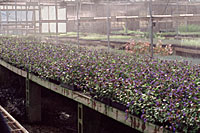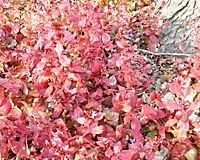Terry L. Ettinger Horticulture Consulting Services
Meeting The Needs Of Today With A Vision For The Future
Recommended Perennials -
Leadwort
 Regardless that I've seen propagation greenhouses filled with tens of thousands of young leadwort plants over the years,
at right, this widely
adaptable, extraordinarily long-blooming perennial is downright rare in Central New York landscapes.
Truth be told, despite its many attriibutes, I don't often include
it in landscape and garden designs I create for clients - though I
vow to do so more often in the future!
Regardless that I've seen propagation greenhouses filled with tens of thousands of young leadwort plants over the years,
at right, this widely
adaptable, extraordinarily long-blooming perennial is downright rare in Central New York landscapes.
Truth be told, despite its many attriibutes, I don't often include
it in landscape and garden designs I create for clients - though I
vow to do so more often in the future!
Native to open woodlands throughout much of western China, leadwort was introduced to North American gardens in the mid-1800's.
 The plant consists of a relatively sparse, rhizomatous root system (modified underground stems from which roots emerge)
from which several stringy, eighteen inch-long stems emerge in late May, or even early June,
at left.
The plant consists of a relatively sparse, rhizomatous root system (modified underground stems from which roots emerge)
from which several stringy, eighteen inch-long stems emerge in late May, or even early June,
at left.
Because the shoots and leaves come out so late in the spring, leadwort makes an excellent companion plant for many spring-flowering bulbs - its newly emerging stems and small, mint-green leaves can hide the dying foliage of the bulbs.
 Beginning in mid- to late July, leadwort really becomes a player
in the garden as its extraordinary, electric indigo flowers appear.
In the low light of very early morning or dusk, the flowers are
iridescent!
Beginning in mid- to late July, leadwort really becomes a player
in the garden as its extraordinary, electric indigo flowers appear.
In the low light of very early morning or dusk, the flowers are
iridescent!
Not only are the flowers effective in July, they're also just as numerous in August, September, and even right through the first hard frosts of October.
 The incredible display of flowers isn't the only ornamental feature of this plant. After it's exposed to the above-mentioned
frost, the leaves turn a very attractive dusty red that provides an attractive backdrop for the last flowers of the season - in some
years, into early November!
The incredible display of flowers isn't the only ornamental feature of this plant. After it's exposed to the above-mentioned
frost, the leaves turn a very attractive dusty red that provides an attractive backdrop for the last flowers of the season - in some
years, into early November!
Leadwort, when you can find it at local garden centers, is sold in small containers. Since each plant will eventually grow into a mat of tangled stems that are a little less than a foot tall and a little less than two feet in diameter, you'll want to space plants about eighteen inches apart for quick cover, or a dozen plants per square yard (three feet by three feet).
 Once
established, leadwort is surprisingly well-adapted to both
relatively damp soils (though not standing water), and those that
can become quite dry for short periods during the middle of the
summer. It also grows well in full sun, at right, providing the soil
doesn't go bone dry, as well as fairly deep shade.
Once
established, leadwort is surprisingly well-adapted to both
relatively damp soils (though not standing water), and those that
can become quite dry for short periods during the middle of the
summer. It also grows well in full sun, at right, providing the soil
doesn't go bone dry, as well as fairly deep shade.
Finally, unlike many/most perennials, there's little need to cut this plant back in the spring as the remnants of its thin stems pretty much decompose over the course of the winter. And, if you want more leadwort, simply dig up shovelfuls of the plant at any point during the growing season and transplant it pretty much wherever you'd like!